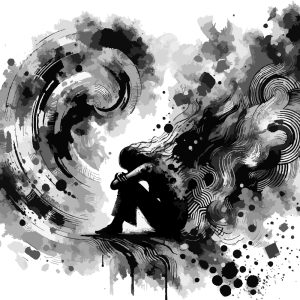I. Introduction

Hoarding is a problem that is often not well understood and carries a lot of stigma. It creates significant difficulties for people who experience its negative effects. It involves keeping too many possessions and not being able to throw things away, which can hinder one’s daily life and relationships. As society tries to understand this behavior better, it is important to look into counseling methods that can help those who are affected by hoarding. This initial discussion aims to place hoarding in a wider psychological picture, emphasizing the need to grasp its root causes, such as anxiety and past trauma. Additionally, it will highlight the essential role of mental health professionals in aiding recovery and encouraging better decision-making habits. In the end, by examining the details of hoarding and its treatment, this essay intends to shed light on recovery options for those impacted and promote increased understanding in society.
AIHCP offers a variety of mental health counseling certifications as well. While clinical counselors deal with such pathologies as hoarding, many non clinical and clinical counselors alike earn certifications in grief counseling, crisis counseling, anger management and stress management that can offer skills to deal with issues that exist within larger mental pathologies.
A. Definition of hoarding disorder
Hoarding disorder is marked by trouble when it comes to throwing away or giving up items, which results in the buildup of belongings that crowd living areas and interfere with regular use. This disorder is not just a habit of collecting; it shows deeper psychological problems often tied to anxiety and difficulty making decisions. People with hoarding disorder might view their belongings as having personal value or be afraid that getting rid of items could lead to missed chances or regrets. As a result, this behavior may cause significant stress and hinder social, work, or other areas of life. Moreover, hoarding can impact families and communities, illustrated by cases of animal hoarding where the neglect of pets often reflects the seriousness of the disorder. It is crucial to understand the complex nature of hoarding disorder to create effective counseling methods that can ease the related symptoms and enhance the quality of life for those affected (Lee et al., 2017)(Lee et al., 2017).
B. Prevalence and impact on individuals and families
Hoarding disorder is a big problem for both people and their families, causing a mix of emotional, social, and money-related issues. Studies show that around 2-6% of people have hoarding issues, which can lead to a lot of distress and problems with everyday life (cite3). People with hoarding disorder usually live in worsening conditions, have troubled relationships, and feel more shame and isolation. Families have a hard time dealing with the physical and mental effects of their loved ones’ actions, such as intervention fatigue and a greater burden on caregivers. Plus, the financial effects can be serious, involving costs for cleaning, health emergencies, and property damage (cite4). Understanding these various effects is important for counselors who want to give good support, as they need to focus on not just the individual symptoms but also the larger family dynamics that play a role in hoarding situations.
C. Importance of effective counseling strategies
Good counseling methods are very important for dealing with the problems that come with hoarding disorders, as they greatly affect how well treatment works for those who are affected. A clear understanding of the psychological reasons behind hoarding is crucial for counselors so that they can work well with clients and promote real change. For example, new therapy methods that include cognitive-behavioral techniques can help clients question the thoughts and feelings that lead to their compulsive actions. Also, since hoarding is complicated, treatments need to be customized for each person’s situation, making sure that the strategies fit with each client’s specific experiences and needs (Cardenas et al., 2009). Importantly, the effects of hoarding go beyond just the person, affecting families and communities, which highlights why counselors need to also look at relationships and social issues (Lee et al., 2017). By using effective counseling methods, practitioners can help clients grow personally and also support the well-being of the wider community.
II. Understanding Hoarding Disorder
Hoarding disorder is more and more seen as a complicated mental health problem. It is marked by ongoing trouble getting rid of things, leading to a mess that interferes with living spaces and greatly affects daily activities. To understand this disorder well, one needs to take a multi-part view that includes psychological, emotional, and social aspects. Studies show that hoarding often happens along with other mental health issues, making treatment more difficult and highlighting the need for specific therapy plans (cite8). Cognitive Behavioral Therapy (CBT) has been found to be a helpful treatment, showing it can adjust to meet the special needs of people who hoard (cite7). This adaptability lets therapists use particular methods that focus on mistaken beliefs about belongings, leading to better treatment results. As understanding of hoarding disorder increases, it is vital to push for better mental health services and support systems that recognize the complex lives of those affected.

A. Psychological factors contributing to hoarding
Understanding the mental reasons for hoarding behavior is important for helping those with this problem. People who hoard often have issues like anxiety, obsessive thoughts, and strong emotional ties to their belongings, which they use to deal with feelings of loss or low self-worth. Studies show that many hoarders go through bad life events or ongoing stress that can make their need to gather and keep things worse (Lee et al., 2017). Also, they often struggle to throw things away due to thinking errors, such as placing too much value on their items and irrational fears of not having enough in the future, which makes it hard for them to make decisions. Therefore, tackling these mental issues through therapy can help develop better ways to cope and enhance overall well-being. By understanding these connections, counselors can adjust their methods to better assist clients dealing with the difficulties of hoarding (Lee et al., 2017).
B. The role of trauma and life experiences
Knowing how trauma and life experiences play a role is important when helping people with hoarding disorders, as these issues often help create and keep up the condition. Many people who hoard have faced major life stressors like loss, abuse, or other traumatic situations, leading to feelings of powerlessness and an incorrect desire for control through possessions. Research shows that effective therapies, like Cognitive Behavioral Therapy (CBT), can tackle the emotional roots of hoarding by looking at these traumatic events and changing how clients view their items (Hajjali et al., 2021). Additionally, a complete approach that checks the mental health services these individuals use is needed to better customize treatment options, which can improve recovery results (Cardenas et al., 2009). Thus, recognizing trauma and life experiences is crucial in developing a well-rounded counseling plan for those dealing with hoarding.
C. Co-occurring mental health conditions
Hoarding behavior is complicated by other mental health issues like obsessive-compulsive disorder (OCD) and depression. Studies show that people with these issues often have similar symptoms, making it harder to diagnose and treat them ((Moroney et al., 2017)). In the case of hoarding, the urge to collect items, along with the stress of throwing things away, can make feelings of hopelessness worse, increasing depressive symptoms. Also, hoarding disorders affect family members and the wider community, creating a cycle of problems that needs organized intervention ((Gail et al., 2022)). It is important to understand how hoarding and these other conditions interact in order to create effective counseling methods. By focusing on both the hoarding behaviors and the underlying mental health problems, counselors can create a more complete treatment plan that supports lasting recovery and a better quality of life for those involved.
III. Counseling Techniques for Hoarding
Counseling people who have hoarding issues needs a careful method that fits their special psychological and emotional situations. Compulsive hoarders often have strong emotional ties to their things, which makes therapy harder (cite16). Counselors must first build a connection that values the client’s caution—a normal way to protect themselves from more emotional pain, especially if they have faced trauma in the past (cite15). Using methods like cognitive-behavioral therapy (CBT) can help clients confront unhelpful thoughts linked to their belongings. Slowly guiding clients to let go of items, along with teaching them about how hoarding affects their mental health and finances, can help them make real progress. In addition, including family members in the therapy can give important support and help create better choices about possessions, leading to a way to recovery.

A. Cognitive Behavioral Therapy (CBT) approaches
Cognitive Behavioral Therapy (CBT) methods are very important for dealing with hoarding behaviors, which often show up as a hard time getting rid of items due to stress and strong emotional ties. A key part of CBT is figuring out and changing harmful beliefs about possessions, with therapy methods aiming to reshape these beliefs. For example, therapists might use exposure exercises to help clients slowly face anxious situations related to getting rid of things, helping them get used to the distress involved. Research shows that mixing exposure and response prevention strategies can improve treatment results, especially for those who are not open to typical approaches ((Jones et al., 2014)). Additionally, it is important to have a good grasp of the psychological factors involved, like past trauma and compulsive actions, to customize the interventions ((Sarno et al., 2009)). In the end, using a structured CBT approach helps therapists to systematically tackle the challenges of hoarding, encouraging significant behavioral changes and better emotional health.
B. Motivational interviewing and its effectiveness
Motivational interviewing (MI) is being seen more and more as a good counseling method for helping with hoarding disorder, mainly because it focuses on the patient and encourages them to want to change. By creating a caring and non-judgmental space, MI steers clear of confrontational tactics that can increase resistance, which is often a big issue when treating hoarding behaviors. Studies show that MI can improve a client’s willingness to participate in treatment, letting them think about their personal values and goals tied to cleaning and organizing their homes. Additionally, MI has been used along with cognitive-behavioral therapy (CBT) to help people tackle issues like self-stigma and emotional bonds to their belongings, leading to better results. Serving as a pathway to more structured treatments, MI helps clients face the underlying mental health issues related to hoarding, pointing to a hopeful direction for effective therapy (Krafft et al., 2021). Therefore, adding MI into treatment plans provides a useful method for helping those struggling with hoarding make significant changes.
C. Family involvement in the counseling process
In counseling people who have hoarding issues, getting the family involved is an important part of the therapeutic process. Involving family members not only gives emotional support to the hoarder but also helps everyone understand the psychological reasons behind the behavior better. Family can share important information about the hoarder’s background and relationships, which helps the counselor’s method. Also, as mentioned, working together can create a more lasting effect, lowering the chances that hoarding behaviors will return, which often goes over 100% without help ((Lee et al., 2017)). Good therapy includes teaching families about hoarding so that they can notice symptoms and stop behaviors that support the cycle. Overall, including family members leads to a broader approach, improving treatment outcomes and helping to create a supportive environment that honors the dignity and independence of the hoarder.
IV. Challenges in Counseling Hoarding Clients

Helping people who hoard things has many special challenges that need a specific therapy method. Clients usually have strong feelings tied to their belongings, making therapy more difficult, as these feelings can cause a lot of stress when they are faced directly. Additionally, thinking errors, like putting too much value on items and being unable to decide what to throw away, often slow down the treatment process (cite23). The presence of other problems, like anxiety or depression, which often come with hoarding, can make these issues worse, so it’s important for counselors to use a varied treatment strategy. Techniques like Cognitive Behavioral Therapy (CBT) have been helpful in dealing with these problems, helping clients change their thinking and slowly face their fears (cite24). In the end, effective counseling needs time, understanding, and a clear grasp of the inner psychological factors that lead to hoarding.
A. Resistance to change and denial
Resistance to change is a big problem in counseling people who have hoarding issues, often showing up as denial about how serious their situation is. Many individuals with hoarding behavior may seem defensive because they have a strong need to control their surroundings, which can block the therapy process. As practitioners in the field have pointed out, these patients often struggle to recognize how their compulsive actions affect them, making it hard to have real conversations about needed changes (Sarno et al., 2009). This resistance can get worse if there is a background of trauma or upsetting experiences, which can intensify feelings of vulnerability when facing the need to change. Research on motivation to change in similar disorders shows that less willingness to change is linked to greater symptom severity, highlighting the difficulties counselors encounter when dealing with denial and avoidance behaviors (Link et al., 2004). Therefore, it is important to create targeted interventions that acknowledge the emotional defenses of the patients while gradually encouraging their willingness to change, which is key for effective hoarding treatment.
B. Emotional attachment to possessions
The strong feelings people have for their belongings are often a main problem in therapy for those with hoarding issues. Many hoarders feel deep bonds with their things, seeing them as parts of who they are or as containers for important memories. This strong attachment makes it hard to let go, causing severe anxiety at the thought of getting rid of items, no matter how useful or valuable they are. Therapists are increasingly aware of the complex connection between emotional pain and compulsive collecting habits, as shown in research that emphasizes how past trauma, like childhood abuse, can strengthen these behaviors (Sarno et al., 2009). Since the emotional burden of possessions makes treatment more difficult, it is clear that interventions need to be customized to address these strong feelings (Cardenas et al., 2009). Therefore, effective therapy must include methods that gently challenge these attachments while helping individuals process their emotions in a healthier way.
C. Ethical considerations in intervention
Ethical issues in intervention are very important when dealing with hoarding, as counselors must manage the sensitive aspects of this behavior. Practitioners need to find a balance between respecting clients’ independence and their duty to protect safety and well-being, making therapy more difficult. Also, people who hoard are often vulnerable, so a caring approach that shows respect and empathy is essential and aligns with ethical principles in counseling standards (Baker et al., 2019). Moreover, sticking to updated CACREP standards is crucial because it emphasizes the need for extensive training on behavioral/process addictions, which helps counselors deal with the specific difficulties of hoarding effectively (Baker et al., 2019). By building a trusting relationship and understanding the complex aspects of hoarding, counselors can promote ethical interventions that empower clients and reduce risks, thus improving the overall effectiveness of treatment.
V. Conclusion

To wrap up, tackling the tough problems faced by those with hoarding disorder requires a well-rounded method that combines psychological, social, and legal views. Cognitive Behavioral Therapy (CBT) has shown to be a useful treatment, proving it can be adjusted to meet the different needs of various clients, including those who have other disorders ((Hajjali et al., 2021)). These customized approaches not only strengthen the relationship between therapist and client but also encourage real changes in behavior. Moreover, the effects of hoarding go beyond the person, impacting families and neighborhoods, as seen in serious cases like animal hoarding, which causes great distress for both pets and their human owners ((Lee et al., 2017)). Therefore, thorough counseling plans should focus on teamwork among mental health experts, community support, and legal systems. By raising awareness and pushing for better handling of hoarding behaviors, we can ultimately aid in the recovery and support of both individuals and their communities.
A. Summary of key points discussed
When looking at the difficulties and methods related to helping people with hoarding problems, a few main ideas come up. First, it is important to know that hoarding is often linked to other mental health problems like anxiety and depression, which makes treatment harder. Good counseling needs a kind understanding of the feelings that lead to the excessive gathering of possessions and the deep distress that both the hoarder and their families feel. It is also important to work with community resources and legal systems since they can offer help during treatment. The challenges of animal hoarding show this need even more; these situations show the wide-ranging effects on both human and animal welfare, stressing the need for complete intervention methods ((Lee et al., 2017), (Lee et al., 2017)). In the end, effective counseling relies on a well-rounded method that mixes compassion with practical answers, seeking to promote lasting changes.
B. The importance of ongoing support and resources
Ongoing help and resources are important for managing hoarding disorder, as the problems linked to it usually go beyond the first treatment. People with hoarding issues need constant access to mental health support customized to their specific needs, especially since some standard treatments like cognitive-behavioral therapy (CBT) might not include important ideas like mindfulness and acceptance (Krafft et al., 2021). Studies show that self-help programs that use these techniques are beneficial, as they offer necessary support that enhances traditional therapy methods (Cardenas et al., 2009). Furthermore, ongoing help creates an atmosphere of accountability and helps lessen the stigma around getting help, which encourages continued participation in treatment. Research has shown that participants who made use of supportive resources had notable improvements, showing that a comprehensive approach that combines ongoing help with available resources is essential for achieving long-term recovery for those dealing with hoarding.
C. Future directions for research and practice in hoarding counseling
As hoarding behaviors become more recognized in mental health talks, future research and practice in hoarding counseling need to change to deal with the complicated nature of this issue. One good way forward is to mix different approaches that look at psychological, social, and environmental factors affecting hoarding. This may include teamwork among psychologists, social workers, and community groups to develop well-rounded intervention plans that not only center on personal therapy but also involve family dynamics and community help. In addition, studying the use of technology-assisted methods, like virtual reality exposure therapy, could boost engagement and offer new therapeutic options. Research that examines the lasting results of different treatment methods is important for finding the best practices. In the end, a complete plan that looks at personal motivations, societal views, and systemic obstacles will greatly enhance the counseling field for those facing hoarding challenges.
Please also review AIHCP’s Behavioral Health Certifications for healthcare and mental health professionals. The programs are online and independent study with mentorship as needed
References:
- Hajjali, Zackary (2021). Cognitive Behavioral Therapy Adaptations for Adolescents with Autism Spectrum Disorder and Co-Occurring Mental Health Disorders: Training for Mental Health Counselors.
- Lee, Courtney G. (2017). Never Enough: Animal Hoarding Law.
- Cardenas, Yadira, Lacson, Girlyanne Batac. (2009). The effectiveness of mental health services among individuals with hoarding syndrome.
- Krafft, Jennifer (2021). Testing an Acceptance and Commitment Therapy Website for Hoarding: A Randomized Waitlist-Controlled Trial.
- A Bandura, A Kendurkar, A Pinto, AP Guerrero, AT Beck, AT Beck, AT Beck, et al. (2010). Correlates of Obsessive–Compulsive Disorder in a Sample of HIV-Positive, Methamphetamine-using Men Who have Sex with Men.
- Lee, Courtney G. (2017). Never Enough: Animal Hoarding Law.
- Poleshuck, Laura R (2013). Living at home with dementia: a client-centered program for people with dementia and their caregivers. https://open.bu.edu/bitstream/2144/11026/11/Poleshuck_Laura_2013_nosig.pdf
- Moroney, Krystal (2017). The relationship between obsessive-compulsive disorder and depression in the general population.
- Gail, Leslie (2022). Factors Influencing Community Responses To Hoarding: Evaluating Operational Culture Of Hoarding Task Forces, Stigma, And Successful Outcomes.
- Sarno, Albert (2009). A Phenomenological Study of Clinicians Treating Traumagenic Compulsions Resulting from Childhood Sexual Abuse.
- Canale, Anthony, Klontz, Bradley (2013). Hoarding Disorder: It’s More Than Just an Obsession – Implications for Financial Therapists and Planners.
- Link, Darlene Davis (2004). Role of Motivation to Change on Treatment Outcome in Individuals with Anorexia Nervosa.
- Buchanan, Greg, Davison, Tanya, George, Kuruvilla, Hudgson, et al. (2007). An individualized psychosocial approach for “treatment resistant” behavioral symptoms of dementia among aged care residents. http://hdl.handle.net/10536/DRO/DU:30007583
- Jones, Heather M. (2014). Predicting Outcome at Posttreatment for Adolescent Obsessive-Compulsive Disorder in a Residential Treatment Setting.
- Bulut, Sefa, Subasi, Mustafa (2020). Group therapy in adults with obsessive-compulsive disorder: A review.
- Hoarding Disorder. Mayo Clinic. Access here
- Hoarding Disorder. Cleveland Clinic. Access here














